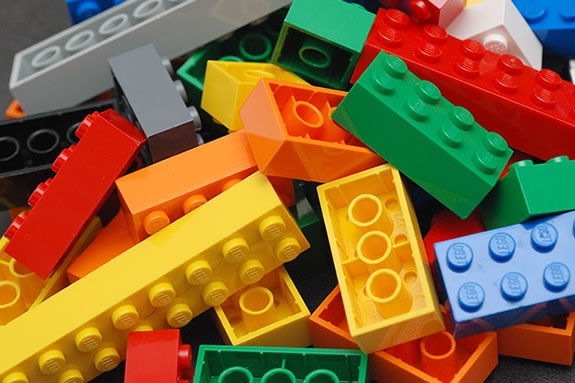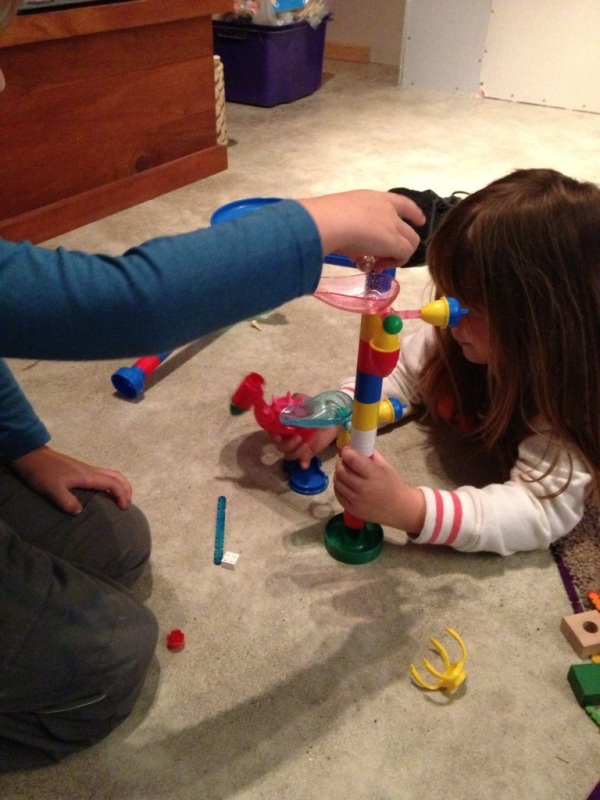Dear Parents,
One day your child will be in school, real school some like to say
Where they sit at a desk, stuck in a chair and can’t go outside to play
There will be homework to do, lessons to learn, not enough time in the day
And you will look back on their early years and long for when they could “just play”
Yes play is the business of childhood
Play is what they have to do
In order to learn how to live in this world
They are practicing at being you
Every moment they’re learning
Even throwing and catching a ball!
Making mud pies, going on walks,
Helping a friend when they fall.
Play is much more than we realize
Play is far more than it seems
It goes beyond counting and numbers
and far beyond just ABC’s
If play is the purpose of childhood,
Then children should play all the time!
So let’s let the children be children
Before they leave childhood behind
~Gemma Medina
Monthly Archives: August 2013
Why All The Questions?
In my line of work I am involved in running many teacher workshops and professional learning seminars. The focus of nearly all these workshops are around advocating the importance of child-directed play, and creating learning opportunities for children to build on problem solving skills and their ability to self-regulate. The underlying theme for teachers participating in these workshops lies around them ‘backing off’ their learners and not satisfying the innate need to continually assess their students throughout every moment of the day.
So it really made me consider exactly how entrenched this need is by teachers to question and assess their students when observing a teacher in a recent workshop, who, despite being explicitly told to stay quiet in a role play, began directing the child in their play. The child was playing by themselves in a construction task and was joined by the teacher. Rather than observing and commenting, 95% of the teacher’s communication involved probing questions. “What are you making?, What do you think will go on there?, What is the best piece to use?” Suddenly a quiet activity the child was in charge of had turned into one in which they were required to respond to a barrage of questions, offering answers to satisfy an adult rather than concentrating on their self-chosen play activity.
Why do teachers have a default position of question, question, question? And why does every move a child make need to be questioned, dissected and assessed? What happened to allowing children to exploring their world in their own time, without the pressures of having to then explain it to someone else? I can appreciate, as a trained teacher, the importance assessment plays in ensuring we are pitching our teaching at a level suitable to the children in front of us. But surely this applies to the areas of the curriculum we are focusing on, such as our reading lesson, numeracy or science experiment. (Even then teachers over-question). So why then do we need to question everything so that we can continually monitor and assess their learning and understanding of life?
One of the biggest reasons teachers seem to cut-to-the-chase and go straight for the questioning technique, would be the ever decreasing amount of time available to teachers in the classroom. When I went through teachers college (and it wasn’t that long ago) we were taught a variety of assessment strategies to deploy in order to gauge a child’s understanding. One of these strategies was observation. The art of keeping quiet and simply watching. Stepping away from the context of the child’s learning and becoming a fly on the wall……an unobtrusive observer, rather than an active participator. Having time to draw on this method is extremely limited in todays classrooms. And yet have teachers considered how it may change the way the children make sense of their learning if trusted to engage in an activity that they will have total autonomy over?
Yes, teachers will still be required to guide some children, particularly those who struggle to manage themselves independently, or those who are just beginning to problem-solve. But would these students advance more steadily in the development of these skills if they understood there was no expectation for them to then answer twenty questions by the teacher to prove what they had learned? Instead they may feel more valued by their teacher if she/he simply commented on what they had observed their student doing, and implied the knowledge they might’ve gained from the activity, with no pressure to confirm or deny. Their teacher actually took the time to watch them..
This is particularly pertinent to intelligent young boys. The problem-solvers, risk takers and ‘doers’ we have in our classrooms. Their learning happens in the moment. When the activity is over, they have already moved on. So consider how it must feel to then be required to answer questions about something in their minds is over with. Or consider, even, if you were in the middle of an intense ‘thinking’ task, only to be interrupted by someone wanting you to then have to explain your every decision. Yes, it may encourage deeper thinking……but we also run the risk of turning our children off in their learning for the sake of our questions. No point doing it, if we then have to answer a lot of questions after its done. That’s just too much like hard work.
From observing the interaction with the teacher and student during a play activity recently, I came to a very simple conclusion. Teachers need to learn to be happy with silence. Their own silence. They need to assess with their eyes more and their questions less. But even more so, they need to be questioning themselves. Is this really something I need an answer to? Is it an assessable activity…..or is it just a good bit of unadulterated fun? Can i trust the child to enjoy themselves, learn for themselves and make sense of their own learning, without me feeling the need to question and encourage ore learning? A simple conclusion, but I rather suspect far easier said than done!
How playing with your child will help them at school
If parents have ever wondered what more they could be doing to either prepare or support their children while at school follow the link at Kiwi Families for the latest article contributed by Cheeky Kids. This is a great website for families and the latest edition focuses on all aspects of Active Families. Be sure to check it out!
Throw Away the Instructions
I am known for purchasing ‘educational’ toys, games and resources as an alternative to the endless (and often mindless) stuff available to children these days. I actively try to avoid games that provide little challenge to my children, offer violence as a form of attraction or sexualised concepts such as boyfriends, inappropriate clothes and makeup. I figure my 3 and 6 year old have all the time in the world to become familiar with these adult concepts, so in the meantime I will give them as much opportunity as I can to be kids. To use their ‘kid power’ to grow their creativity, imagination and intelligence all the while preserving their wonderful innocence of youth.
So despite feeling like I’m pretty aware when purchasing toys, I have still made an interesting discovery about two well-loved toys, known for their ability to encourage creative and deeper-level thinking. Lego, historically, I am sure, has been responsible for the stimulation of creative thought processes in young inventors for many decades. More recently, Marble Run has blossomed onto the market, appearing nationwide in classrooms as students test the many laws of physics in order to have the marble race down the track to the finish line. Despite having these two sets of toys in our house for the past few years, it was only this morning that my children truly used them in an unadulterated, purely creative manner. And why, after all this time of having them in our house? Because I threw out the instructions for their use.
Marble Run comes with a variety of pieces that, when joined together can create mind-boggling towers and paths with which to run a marble from top to bottom. It is about deciding the most creative ways with which the marble can wind, spin, rotate and speed down to the end of the run. In the same game is a brochure demonstrating the sorts of structures the manufacturer suggests children could make with the pieces. When my children were given this game, they initially explored how to use the pieces and familiarised themselves with the concept. And then my son found the instructions along with the visual examples of structures he could make. The focus drastically changed. Instead of spewing forth with ideas and trials in creating his own structure, he held up the instructions and said ‘Mummy I want to make that one’. Suddenly his ‘kid power’ was switched off and he desired the easiest option available – that of imitation. He no longer was hypothesising, problem solving, imagining and creating. He simply wanted a copy of someone else’s idea.
So the instructions magically disappeared from the package one day in our house, never to be found again. Their absence has not been missed. And this morning we saw the benefits of this in my son and his sisters play. Not only did they both create unique structures, but when his top-heavy creation did not balance by itself, he was able to problem solve a solution. He learned the technique of counter balancing. He also learned the art of trial and error, as well as the skills of patience, turn-taking and compromise. All because he was working toward the picture in his head, rather than the picture on the paper. When both he and his sister had created their own structure, they then found a way to combine them both into a super structure, from which the marble could travel through extensively. The sense of achievement as the marble raced through its first successful run was immeasurable. The excitement and enthusiasm to better each run was infectious and the engagement by both children was high. Far more than I had observed in any previous play with the same equipment.
So engaged in the creative process that he remembered the Lego packed away in the wardrobe. The big container was pushed out and the lid opened. As he dug through the box he unearthed a pamphlet showing once again a variety of suggestions of use that had once been attached to a Lego package. ‘Mum, I want to make a fire engine’. Back to square one. Now to have those instructions magically disappear………









